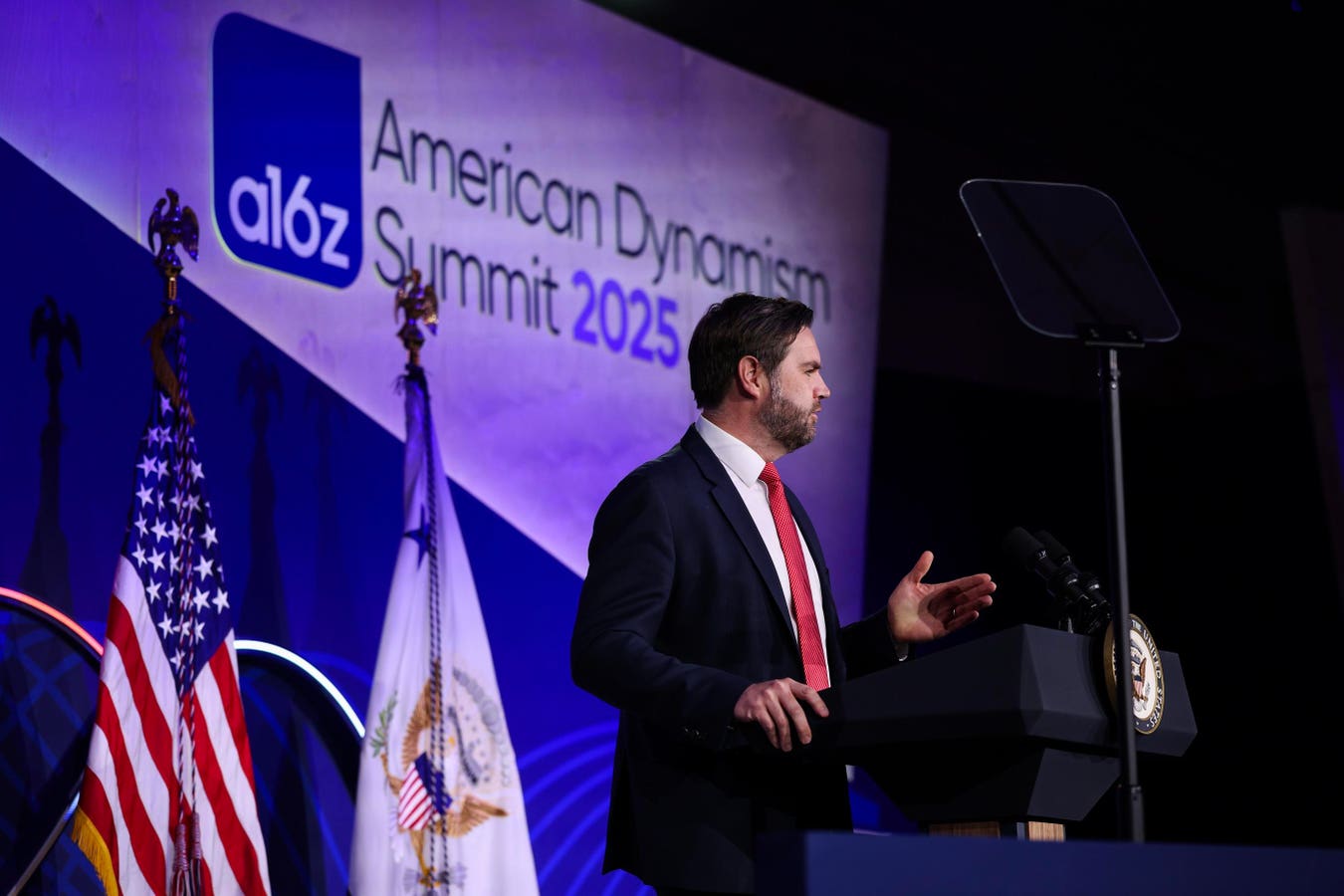Vice President JD Vance speaks in Washington, DC., during the 2025 American Dynamism Summit on March 18, 2025, hosted by the venture capital firm Andreessen Horowitz (a16z).
Getty Images
A group of tech leaders and artificial intelligence companies announced the creation of Leading the Future (LTF), a new organization designed to, in its words, “ensure the United States remains the global leader in AI by advancing a clear, high-level policy agenda at the federal and state levels and serving as the political and policy center of gravity for the AI industry.” The industry is no longer happy to shape policy through think tanks, white papers, and voluntary commitments. It is building a political influence infrastructure.
Who Is Behind LTF
The coalition includes powerful venture capital firms like Andreessen Horowitz, investors such as Ron Conway (one of Silicon Valley’s super angels with early investments in Facebook, Google, Airbnb and Reddit), Joe Lonsdale (Palantir cofounder and an early executive at Clarium Capital, Peter Thiel’s hedge fund), Greg Brockman (OpenAI cofounder and current president) and his wife Anna Brockman. Even though the announcement is short on specific names, it indicates the participation from leading firms, including Perplexity.
Their motivations are clear in their intent to promote policies to advance the economic benefits of the technology and oppose efforts seen as limiting and delaying its development in the US. They frame the stakes in AI as not only commercial but also geopolitical. With Washington and Beijing locked in a struggle over compute power, export controls, and data supply chains, tech leaders want a direct line into state capitals and the halls of Congress.
Earlier lobbying by the internet sector focused on shaping policy through public campaigns, portraying themselves as defenders of the users, internet freedom or innovation. They often leaned on trade associations. Differently, LTF brands itself as an independent political entity. The initiative is a well-funded, centralized advocacy effort positioned to shape the future direction of tech policy in the country. It resembles historical efforts in business, food, tobacco, pharma, and other sectors with well-coordinated lobbying and electioneering to secure favorable outcomes.
Lessons from Web 2.0
This is not the first time Silicon Valley has built influence in Washington. In the late 2000s, as regulators debated privacy, antitrust, and liability protections, internet companies expanded their lobbying spend. Google went from negligible activity in the early 2000s to being among the top corporate lobbyists by the early 2010s. Facebook followed suit, building networks of state and federal lobbyists while fighting attempts to tighten rules on data collection.
Those efforts were defensive, aimed at forestalling oversight that might slow growth. Silicon Valley’s attitude toward Washington during Web 2.0 was generally one of avoidance, with tech leaders’ preference for minimal governance and free-market growth. Most companies neglected formal lobbying until faced with scrutiny, potential regulation or in response to crises. The relationship was characterized by mutual unfamiliarity, with many in DC underestimating the tech sector’s potential impact on policy, and tech companies believing they could bypass government oversight by focusing solely on innovation.
By contrast, LTF presents itself as offensive: it wants to shape an affirmative agenda and frame the policy debate itself.
Regulatory Capture and AI
Economists and legal scholars have long warned about the dangers of industries capturing the agencies tasked with regulating them. George Stigler, in his seminal 1971 essay The Theory of Economic Regulation, argued that “as a rule, regulation is acquired by the industry and is designed and operated primarily for its benefit”. He introduced the concept of regulatory capture and shifted the understanding of regulation from the public interest model to a rational business choice. One of his insights was that companies often prefer regulatory control over subsidies. Rules that restrict entry, shape market structure, or favor complements can create more lasting advantage than direct government handouts.
Stephen Breyer, writing in Regulation and Its Reform (1984), documented the recurring pattern of regulatory failure in America: high costs, low returns, procedural gridlock, and unpredictability. Cass Sunstein added a twist in his 1990 essay Paradoxes of the Regulatory State: sometimes well-intentioned regulation backfires, producing the opposite of its intended effect.
Silicon Valley Bank’s 2023 collapse, the second largest in U.S. history, resulted from risky management, overinvestment in long-term bonds losing value as rates rose, and a rapid $42 billion bank run. This crisis is an example of how regulatory capture and policy changes, like the post-2018 rollback of Dodd-Frank provisions, can backfire. Regulatory failures included delayed, insufficient oversight due to weakened post-2018 rules, procedural gridlock, and unpredictability.
These perspectives suggest that as AI evolves, the risk is not just over- or under-regulation, but that industry itself will be the architect of the rules. AI offers fertile ground for capture. The technology is complex, opaque, and evolving quickly. Regulators often lack the expertise or resources to challenge the claims of leading labs. This creates an asymmetry: the firms that dominate model training are also those most capable of defining the safety benchmarks, compliance metrics, and standards of responsible AI.
Money in Politics Today
The timing of LTF’s launch is no accident. The Supreme Court’s Citizens United decision in 2010 opened the door to unlimited corporate spending on political speech through Super PACs and 501(c)(4) “social welfare” groups. These entities can raise and spend vast sums, often with limited transparency. Tech leaders are familiar with these vehicles, and crypto companies have used them aggressively in the 2024 election cycle.
By creating LTF as a political hub, the sector signals it intends to play at the same level as defense contractors, pharmaceutical giants, and oil companies. The group can funnel money into congressional races, shape ballot initiatives, and build permanent influence networks. And because AI touches multiple policy domains—national security, labor, education, healthcare—the scope of lobbying is potentially broader than any prior technology sector campaign.
The sums at stake are enormous. Training frontier models requires billions of dollars in chips and energy. Securing government contracts for AI in defense, intelligence, and healthcare could yield recurring revenue streams. In this context, spending hundreds of millions on political influence is rational, and perhaps necessary, for firms seeking to entrench their market position.
Possible Futures for AI Policy
The creation of LTF raises the question: Is AI governance going to follow a pattern of capture, or can policymakers create structures to resist it?
On one path, industry sets the rules. Companies use their clout to define the pathways that align with their business models. They shape federal preemption laws that limit state experimentation. They fund think tanks and university programs that validate their frameworks. This would mirror what Stigler described as the normal course of regulation: industries acquiring and shaping the state’s coercive power for their own benefit.
On another path, policymakers build more resilient institutions. Breyer’s framework suggests starting with clear objectives, examining alternative methods, and choosing the least intrusive regulatory form. Sunstein warns against paradoxes, where well-meaning but rigid rules lead to enforcement paralysis. Applied to AI, this means balancing innovation with safeguards, ensuring that agencies have the expertise to evaluate claims, and creating accountability mechanisms that cannot be dominated by a handful of firms.
Will AI policy become another case study in capture or a demonstration that democratic institutions can adapt to a general-purpose technology? From railroads to telecoms to energy, industries with concentrated wealth and technical expertise have usually succeeded in bending rules to their favor. But AI also raises existential concerns, from misinformation to labor disruption to military use, that broaden the coalition demanding oversight.
The launch of Leading the Future formalizes what had been implicit: AI is not just a technological race but also a contest over policy and influence. The outcome will depend on whether policymakers heed the lessons of Breyer, Stigler, and Sunstein or repeat the familiar cycle of regulation designed by and for the regulated.
Money will play a decisive role, as it always has in American politics. But the stakes in AI are larger than market share.









